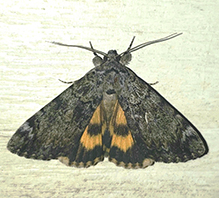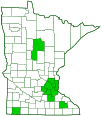little underwing
(Catocala minuta)
Conservation • Description • Habitat • Ecology • Distribution • Taxonomy
|
||||||||
| Hodges # | 8874 |
|||||||
Conservation Status |
||||||||
| IUCN Red List | not listed LC - Least Concern |
|||||||
| NatureServe | NNR - Unranked |
|||||||
| Minnesota | not listed |
|||||||
Description |
||
Little underwing is a common, small, highly variable moth. It occurs in the United States and southern Canada east of the Great Plains. It is found wherever its host species is found. In Minnesota, the larvae feed on the leaves of honey locust, and adults are active in June and July. In the south, the larvae feed on both honey locust and water locust, and adults are active from June to August. Adults are ¾″ to 15⁄16″ (19 to 24 mm) in length and have a 1⅜″ to 1¾″ (34 to 45 mm) wingspan. Moth sizes are sometimes given in terms of forewing length, which for this moth is ⅝″ to ¾″ (17 to 19 mm). Five forms have been described based on coloration and markings. Three were later treated as subspecies or as distinct species. All of them are now treated as synonyms of a single highly variable species. The head is prominent. The compound eyes are large and hairless. The sensory mouthparts (labial palps) are turned upward and are long, reaching to the top of the head or above. The forewings are mottled with light and dark shades of the same color. That color is usually grayish brown, but it may be brown or gray. The wings are sometimes tinted greenish. They are crossed by jagged black or blackish lines. The antemedial (AM) line is shadowed above by a pale line. It is sometimes indistinct. The postmedial (PM) line is sharply angled rearward and wavy from the leading edge (costal margin) on the outer third of the wing, then angled forward and sharply jagged to the inner margin. It is always distinct, and it is shadowed below with a pale line. The subterminal (ST) line is pale, toothed, and wavy. It is unbroken, complete from the costal to the inner margin. It expands into a long jagged patch as it approaches the costal margin. The terminal line is a row of black, crescent-shaped marks between the veins. The cryptic, bark-like coloration makes the moth difficult to see when it rests on the trunk or branch of a tree. The “mellitula” form has a black patch between the basal and AM lines from the costal margin to the inner margin. The “parvula” form has a broad black patch along the inner margin. The hindwings are deep yellow or orangish yellow with two broad black bands. The PM band is strongly curved. It connects before the inner margin with a thinner black line that extends forward to the wing base, forming a closed loop. There is additional black shading between the loop and the inner margin. The marginal band is broader. It is complete, not interrupted, but there is a patch of the base color at the outer angle. |
||
Size |
||
Total length: ¾″ to 15⁄16″ (19 to 24 mm) Wingspan: 1⅜″ to 1¾″ (34 to 45 mm) |
||
Similar Species |
||
Habitat |
||
|
||
Ecology |
||
Season |
||
One generation per year: June and July |
||
Behavior |
||
Adults are active at night and will come to lights. They are also attracted to sugar baits. During the day, they rest usually on tree bark with their wings held flat and the hindwings hidden. |
||
Life Cycle |
||
Eggs are laid on tree bark. They overwinter and hatch in the following spring. |
||
Larva Food |
||
Leaves of honey locust |
||
Adult Food |
||
|
||
Distribution |
||||
|
Sources |
|||
| 12/18/2023 | ||||
Occurrence |
||||
Common |
||||
Taxonomy |
|||
Order |
Lepidoptera (Butterflies and Moths) | ||
Superfamily |
Noctuoidea (Owlet Moths and Allies) | ||
Family |
Erebidae (Underwing, Tiger, Tussock, and Allied Moths) | ||
Subfamily |
Erebinae (underwings, zales, and related owlets) | ||
Tribe |
Catocalini | ||
Genus |
Catocala (underwing moths) | ||
Synonyms |
|||
Catocala eureka Catocala hiseri Catocala mellitula Catocala minuta mellitula Catocala minuta parvula Catocala obliterata Catocala parvula |
|||
Common Names |
|||
little underwing |
|||
Glossary
Antemedial (AM) line
A thin line separating the basal area and the median area of the forewing of Lepidoptera.
Costal margin
The leading edge of the forewing of insects.
Orbicular spot
A circular spot or outline in the upper median area near the antemedial line on the forewing of many moths.
Palp
Short for pedipalp. A segmented, finger-like process of an arthropod; one is attached to each maxilla and two are attached to the labium. They function as sense organs in spiders and insects, and as weapons in scorpions. Plural: palpi or palps.
Postmedial (PM) line
A thin line separating the median area and the postmedial area of the forewing of Lepidoptera.
Reniform spot
A kidney-shaped spot or outline in the lower median area near the PM line on the forewing of many moths.
Visitor Photos |
|||||
Share your photo of this insect. |
|||||
| This button not working for you? Simply email us at info@MinnesotaSeasons.com. Attach one or more photos and, if you like, a caption. |
|||||
Babette Kis |
|||||
Catocala minuta (little underwing) Catocala minuta, little underwing, on the house adjacent to Barnes Prairie, Racine Co., WI., June 22, 2021. I seldom see these moths now; they were more common in past years. |
 |
||||
MinnesotaSeasons.com Photos |
|||||
|
|||||

Slideshows |
||

Visitor Videos |
|||
Share your video of this insect. |
|||
| This button not working for you? Simply email us at info@MinnesotaSeasons.com. Attach a video, a YouTube link, or a cloud storage link. |
|||
Other Videos |
|||


Created: 12/18/2023
Last Updated:

